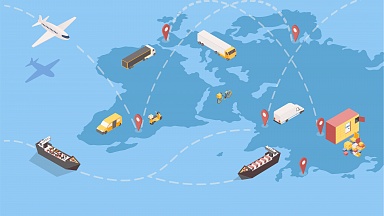The impact of the disruption caused by the partial closure of the key south China Port of Yantian is set to exceed that of the Suez Canal blockage in late March and April, according to senior container shipping sources, with the ripple effects already being felt across supply chains.
Container shipping industry commentator Lars Jensen, CEO of shipping consultancy Vespucci Maritime, today observed that it «clearly currently appears that supply chain problems are worsening and not improving», highlighting that «the impact of the South China port issues continues to escalate», and that the proportion of vessels affected «exceed the Suez incident».
Taking a «quick look at four carriers, across each of the major alliances», he yesterday highlighted that Maersk now advises that 64 of its vessels or its partner vessels in the 2M alliance have omitted Yantian and Shekou, with six switching to call in Nansha or Hong Kong, noting that «this is up from 40 vessels listed just two days ago».
He notes that ONE now advises that 52 of THE Alliance’s vessels are being impacted, with 41 omissions and 11 changes typically from Yantian to Nansha — up from 27 vessels, of which 20 were omissions and seven were port changes, in their last advisory 5 days ago.
In their latest advisory on Tuesday, OOCL lists 26 vessels omitting Yantian and Shekou, while CMA CGM lists 11 vessels omitting Yantian, although four of these list Nansha as an alternative port of loading. Despite CMA CGM and OOCL both being in Ocean Alliance, their lists of impacted vessels do not include each other’s vessels.
«The above will not include all vessels omitting the ports, but these alone add up to 153 vessels impacted and 132 complete omissions of the region,» Jensen noted. «For comparison, the average flow of vessels through the Suez Canal is 14.6 container vessels per day, including both directions. Hence, in the six-day canal blockage, a total of 87 vessels were directly impacted, although the actual number was slightly higher as some vessels were redirected south of Africa instead of being caught in the queue.»
Just-in-time supply chains not working
In a note yesterday on LinkedIn, the EVP for sea logistics for one major global ocean freight forwarder estimated that there were currently «over 300 container vessels this moment waiting» due to disruptions at various ports — including at Yantian and Nansha, LA/LGB, but now also Oakland and Seattle. He warned cargo owners that just-in-time supply chains do not work in the current disrupted ocean freight environment, urging shippers to increase their inventory levels.
He noted: «My bicycle dealer in Hamburg knew about Ever Given, he will soon know, that a port of Yantian exists. Told him to look every day at #SeaExplorer, to see whether situation improves. Shippers better increase inventories. Supply chains are too tight: just in time does not work in these times, consumer demand will remain strong.»
Noting that report that 300 vessels were now waiting due to disruptions at various ports, Jensen said that «if we consider pure cellular containerships, the world fleet has some 5,400 vessels in total. This means some 5.5% of all vessels just sit there waiting. In terms of capacity this is highly likely to be severely skewed towards larger vessels waiting in line and therefore even more in capacity terms.»
But he warns that the situation could get even worse, if the current incidents of Covid-19 at ports in south China become replicated at other Chinese container hubs.
In a note to cargo owners about the need to consider their contingency plan, he observes: "If you are reliant on container shipping services you are of course — unfortunately — fully aware of the almost chaotic state of the market presently where the Covid outbreak in South China is wreaking havoc on the planned sailings — on top of a market already in partial disarray.
But you might want to spend a little time in your organisations to contemplate how to tackle a potentially bigger disruption. Not that I am saying it will happen for sure — I hope it does not; but the risk should not be ignored.
"The disruption unfolding in South China is due to an outbreak of Covid where the authorities want to prevent a further spread. The disruptions to shipping in South China is precisely because of the measures put in place to contain Covid at such low numbers.
"It is a realistic risk that cases might appear in other places of China — such as, for example, Shanghai, Ningbo, Tianjin and other major port areas. Should that happen the disruption to shipping schedules would take on even larger proportions.
He concludes: "Let us hope this will not be the case, but if you rely on freight, what is your contingency plan to deal with this?"



